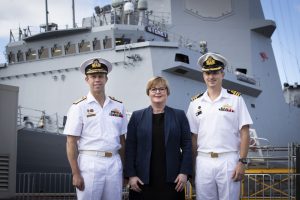The Royal Australian Navy’s (RAN) third and final air warfare destroyer (AWD), the future HMAS Sydney (DDG 42), has officially been delivered to the Royal Australian Navy (RAN) in a ceremony at the Osborne Naval Shipyard in Adelaide on February 28.
The acceptance ceremony was attended by Australian Defense Minister Linda Reynolds and Chief of Navy Vice Admiral Michael Noonan.
“I congratulate the 5000 workers who have worked directly on this program over the past decade, from the design phase through to the construction, integration and delivery of these magnificent ships,” Reynolds, was quoted as saying, according to a statement released by the Department of Defense (DoD). “The significance of this success cannot be understated and is reflected in the truly world-class capability of these warships, and the naval shipbuilding and combat system integration skills that have been developed at Osborne.”
The future HMAS Sydney is the third and final ship of the 7,000-ton Hobart-class of guided-missile (air warfare) destroyers. The first-of-class HMAS Hobart was commissioned in September 2017. The HMAS Brisbane entered service in October 2018. The third Hobart-class destroyer is expected to be commissioned in Sydney on May 20.
Following its commissioning, the Sydney will undergo activation of its combat systems and undergo six months of U.S. Navy Combat System Ship Qualification (CSSQT) trials, which will include test firing the surface combatant’s RIM-66 SM-2 Block 3B and RIM-162 Evolved SeaSparrow Missiles (ESSMs) air-defense missiles.
The Sydney is slated to be equipped with a host of different weapons systems, as I wrote previously:
The armament of the HMAS Sydney will include the Mark 41 Vertical Launching System capable of firing surface-to-air missiles, Harpoon over-the-horizon anti-ship missiles, light-weight torpedoes, and a Mark 45 127-millimeter gun. The warship will also carry a MH-60R Seahawk anti-submarine warfare helicopter.
The Hobart-class is based on the Navantia-designed Álvaro de Bazán-class frigate (aka F-100) currently in service with the Spanish Navy and is the first class of Australian surface combatants to be built around the U.S.-made Aegis combat system and the first ships outside the U.S. Navy to be equipped with a cooperative engagement capability (CEC), a new wide-area integrated air defense system.
“CEC interfaces with the Aegis combat system and enhances its early detection capability,” I explained elsewhere. “It is a new wide-area integrated air defense system that allows the real-time sharing of sensor data on air targets, including incoming enemy aircraft and cruise missiles between CEC-equipped destroyers.”
Notably, the entire Hobart-class will undergo expensive upgrades for the Aegis combat system from the current Baseline 7.1 Refresh 2 configuration to Baseline 9.

































